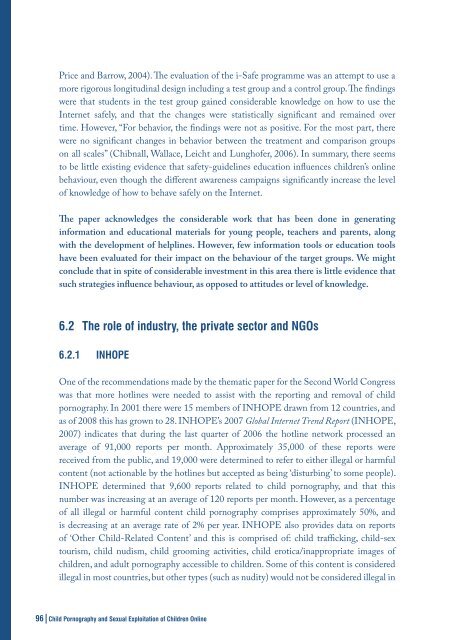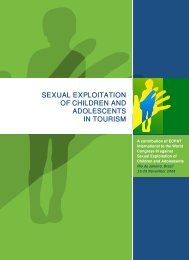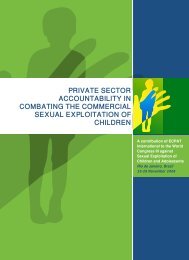Price and Barrow, 2004). The evaluation of <strong>the</strong> i-Safe programme was an attempt <strong>to</strong> use amore rigorous longitud<strong>in</strong>al design <strong>in</strong>clud<strong>in</strong>g a test group and a control group. The f<strong>in</strong>d<strong>in</strong>gswere that students <strong>in</strong> <strong>the</strong> test group ga<strong>in</strong>ed considerable knowledge on how <strong>to</strong> use <strong>the</strong>Internet safely, and that <strong>the</strong> changes were statistically significant and rema<strong>in</strong>ed overtime. However, “For behavior, <strong>the</strong> f<strong>in</strong>d<strong>in</strong>gs were not as positive. For <strong>the</strong> most part, <strong>the</strong>rewere no significant changes <strong>in</strong> behavior between <strong>the</strong> treatment and comparison groupson all scales” (Chibnall, Wallace, Leicht and Lunghofer, 2006). In summary, <strong>the</strong>re seems<strong>to</strong> be little exist<strong>in</strong>g evidence that safety-guidel<strong>in</strong>es education <strong>in</strong>fluences children’s onl<strong>in</strong>ebehaviour, even though <strong>the</strong> different awareness campaigns significantly <strong>in</strong>crease <strong>the</strong> levelof knowledge of how <strong>to</strong> behave safely on <strong>the</strong> Internet.The paper acknowledges <strong>the</strong> considerable work that has been done <strong>in</strong> generat<strong>in</strong>g<strong>in</strong><strong>format</strong>ion and educational materials for young people, teachers and parents, alongwith <strong>the</strong> development of helpl<strong>in</strong>es. However, few <strong>in</strong><strong>format</strong>ion <strong>to</strong>ols or education <strong>to</strong>olshave been evaluated for <strong>the</strong>ir impact on <strong>the</strong> behaviour of <strong>the</strong> target groups. We mightconclude that <strong>in</strong> spite of considerable <strong>in</strong>vestment <strong>in</strong> this area <strong>the</strong>re is little evidence thatsuch strategies <strong>in</strong>fluence behaviour, as opposed <strong>to</strong> attitudes or level of knowledge.6.2 The role of <strong>in</strong>dustry, <strong>the</strong> private sec<strong>to</strong>r and NGOs6.2.1 INHOPEOne of <strong>the</strong> recommendations made by <strong>the</strong> <strong>the</strong>matic paper for <strong>the</strong> Second World Congresswas that more hotl<strong>in</strong>es were needed <strong>to</strong> assist with <strong>the</strong> report<strong>in</strong>g and removal of childpornography. In 2001 <strong>the</strong>re were 15 members of INHOPE drawn from 12 countries, andas of 2008 this has grown <strong>to</strong> 28. INHOPE’s 2007 Global Internet Trend Report (INHOPE,2007) <strong>in</strong>dicates that dur<strong>in</strong>g <strong>the</strong> last quarter of 2006 <strong>the</strong> hotl<strong>in</strong>e network processed anaverage of 91,000 reports per month. Approximately 35,000 of <strong>the</strong>se reports werereceived from <strong>the</strong> public, and 19,000 were determ<strong>in</strong>ed <strong>to</strong> refer <strong>to</strong> ei<strong>the</strong>r illegal or harmfulcontent (not actionable by <strong>the</strong> hotl<strong>in</strong>es but accepted as be<strong>in</strong>g ‘disturb<strong>in</strong>g’ <strong>to</strong> some people).INHOPE determ<strong>in</strong>ed that 9,600 reports related <strong>to</strong> child pornography, and that thisnumber was <strong>in</strong>creas<strong>in</strong>g at an average of 120 reports per month. However, as a percentageof all illegal or harmful content child pornography comprises approximately 50%, andis decreas<strong>in</strong>g at an average rate of 2% per year. INHOPE also provides data on reportsof ‘O<strong>the</strong>r <strong>Child</strong>-Related Content’ and this is comprised of: child traffick<strong>in</strong>g, child-sex<strong>to</strong>urism, child nudism, child groom<strong>in</strong>g activities, child erotica/<strong>in</strong>appropriate images ofchildren, and adult pornography accessible <strong>to</strong> children. Some of this content is consideredillegal <strong>in</strong> most countries, but o<strong>the</strong>r types (such as nudity) would not be considered illegal <strong>in</strong>96|<strong>Child</strong> Pornography and Sexual Exploitation of <strong>Child</strong>ren Onl<strong>in</strong>e
most countries. However, such images can give cause for concern depend<strong>in</strong>g on <strong>the</strong> context<strong>in</strong> which <strong>the</strong>y are acquired and collected and might be thought of <strong>in</strong> <strong>the</strong>se circumstancesas ‘<strong>in</strong>dicative’. The number of such reports received was approximately 3,600 per month <strong>in</strong><strong>the</strong> last quarter of 2006, with an average rate of <strong>in</strong>crease of 51 additional reports per month.‘O<strong>the</strong>r <strong>Child</strong> Related Content’ accounted for approximately 19% of all processed reportsabout illegal or harmful content.However, INHOPE not only receives reports (both from <strong>the</strong> public and through itsown proactive searches), but also takes appropriate action. In <strong>the</strong> last quarter of 2006approximately 6,400 reports per month were made <strong>to</strong> law enforcement agencies. However,INHOPE hotl<strong>in</strong>es rarely received any structured feedback from law enforcement agencies<strong>in</strong> relation <strong>to</strong> <strong>the</strong>se reports. While <strong>the</strong>re may be a variety of reasons for this, <strong>the</strong> reportsuggested that this was demotivat<strong>in</strong>g for staff and, as a result, INHOPE is work<strong>in</strong>g <strong>to</strong>adopt a signed Memorandum of Understand<strong>in</strong>g with national law enforcement agencieswhich would <strong>in</strong>clude feedback <strong>in</strong> relation <strong>to</strong> reports forwarded for <strong>in</strong>vestigation. The matteris fur<strong>the</strong>r complicated as some national law enforcement agencies request that hotl<strong>in</strong>ereports are not forwarded <strong>to</strong> <strong>the</strong>m when content may lie outside <strong>the</strong>ir jurisdiction. Thepaucity of feedback given <strong>to</strong> hotl<strong>in</strong>es by law enforcement agencies is a cause for concern,and it is difficult <strong>to</strong> understand how <strong>the</strong> effectiveness of <strong>the</strong> hotl<strong>in</strong>es can be evaluated <strong>in</strong>terms of <strong>the</strong>ir impact without adequate feedback.6.2.2 IWFThe Internet Watch Foundation (IWF) is a member of INHOPE and takes as its remitthat it will work <strong>in</strong> partnership with ISPs, telecommunication companies, mobile phoneopera<strong>to</strong>rs, software providers, <strong>the</strong> police, government and <strong>the</strong> public <strong>to</strong> m<strong>in</strong>imise <strong>the</strong>availability of potentially illegal onl<strong>in</strong>e content. Dur<strong>in</strong>g 2007 <strong>the</strong> IWF processed 34,871reports, which resulted <strong>in</strong> 2,755 <strong>to</strong>p-level doma<strong>in</strong>s with child sexual abuse content be<strong>in</strong>gassessed, confirmed as potentially illegal and traced; <strong>the</strong> appropriate <strong>in</strong>telligence was <strong>the</strong>ndissem<strong>in</strong>ated (IWF Annual Report, 2007). The overall number of child sexual abusedoma<strong>in</strong>s known <strong>to</strong> <strong>the</strong> IWF appears <strong>to</strong> have rema<strong>in</strong>ed relatively static over recent years.This may suggest that content distributed through <strong>the</strong> World Wide Web appears not <strong>to</strong> beon <strong>the</strong> <strong>in</strong>crease, <strong>in</strong> spite of global Internet access, speed of connection and <strong>the</strong> availabilityof technologies. The 2007 figures also suggest that 80% of child abuse doma<strong>in</strong>s known <strong>to</strong>IWF are commercial operations.The IWF also provides an analysis of abusive images <strong>in</strong> relation <strong>to</strong> <strong>in</strong>telligence that may beseen as actionable and <strong>the</strong>refore passed on <strong>to</strong> CEOP (<strong>the</strong> <strong>Child</strong> Exploitation and Onl<strong>in</strong>eProtection <strong>Centre</strong>, UK). IWF also provides <strong>in</strong><strong>format</strong>ion about <strong>the</strong> children whose images<strong>Child</strong> Pornography and Sexual Exploitation of <strong>Child</strong>ren Onl<strong>in</strong>e |97
- Page 5 and 6:
Child Pornography and SexualExploit
- Page 7 and 8:
6.1.5 Media co-operation 956.1.6 Ev
- Page 9 and 10:
Executive SummaryÜ This thematic p
- Page 11 and 12:
importance for children who are sam
- Page 13 and 14:
Actions to be achieved by 2013Toget
- Page 15 and 16:
Positive advances were also noted,
- Page 17 and 18:
2. Adult perpetrators of abuse2.1 C
- Page 19 and 20:
2 (c) defined child pornography as,
- Page 21 and 22:
Taylor, 2002). In part, this relate
- Page 23 and 24:
Level 7: Explicit Sexual Activity.I
- Page 25 and 26:
and carefree the child seems to be,
- Page 29 and 30:
2.3 The Internet sex offender, the
- Page 31 and 32:
e criminalised before the offender
- Page 33 and 34:
Non-secure collector: This person p
- Page 35 and 36:
This section examines the potential
- Page 37 and 38:
about sexually abusive practices an
- Page 39 and 40:
Activity Number PercentagePhysical
- Page 41 and 42:
searched for files on Gnutella are
- Page 43 and 44:
for a minimum of several months, wi
- Page 45 and 46:
develop a risk assessment that will
- Page 47 and 48:
3. Child victims of abuse via the n
- Page 49 and 50:
that a more conservative estimate w
- Page 51 and 52:
States need to demonstrate investme
- Page 53 and 54: we investigate such cases and how w
- Page 55 and 56: Table 5: Disclosure of abuse throug
- Page 57 and 58: Silbert (1989) made reference to th
- Page 59 and 60: they will have had no control over
- Page 61 and 62: 3.3 Children persuaded and coerced
- Page 63 and 64: all crimes in which the victim thou
- Page 65 and 66: situation have reported to one of t
- Page 67 and 68: programmed to make them difficult t
- Page 69 and 70: disorders, for young offenders with
- Page 71 and 72: ealising how widely they could be c
- Page 73 and 74: contexts, be seen as a consequence
- Page 75 and 76: some people they connect with onlin
- Page 77 and 78: Two studies by Lwin et al. (2008) l
- Page 79 and 80: perhaps reaching the same conclusio
- Page 81 and 82: 4.5.2 Young people accessing child
- Page 83 and 84: Some abusers intent on grooming you
- Page 85 and 86: or young person’s experience of b
- Page 87 and 88: for different psychosocial problems
- Page 89 and 90: A recent study from Ukraine demonst
- Page 91 and 92: paper, such as online abuse where t
- Page 93 and 94: definition in Article 20 - Offences
- Page 95 and 96: • Which is a visual or audio repr
- Page 97 and 98: i. The display of the material by a
- Page 99 and 100: sex offending, this would certainly
- Page 101 and 102: the vast majority who met someone o
- Page 103: 6.1.6 Evaluation of impactFew infor
- Page 107 and 108: of online child sexual abuse conten
- Page 109 and 110: gambling). Based on research commis
- Page 111 and 112: 7. RecommendationsIn preparation of
- Page 113 and 114: Endnotes1Dr. Ethel Quayle, COPINE R
- Page 115 and 116: Bensimon, P. The role of pornograph
- Page 117 and 118: Flood, M. Exposure to pornography a
- Page 119 and 120: Joyce, E. and Kraut, R. Predicting
- Page 121 and 122: Mitchell, K.J., Finkelhor, D. and W
- Page 123 and 124: Shukan Bunshun. Yoji Rape Bon ga Ba
- Page 125: Wolak, J., Finkelhor, D., Mitchell,




